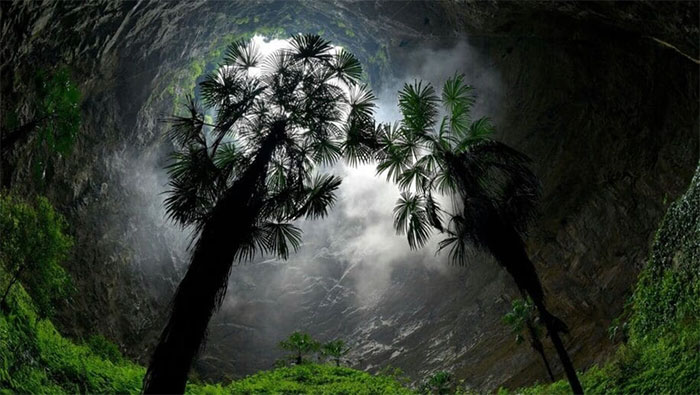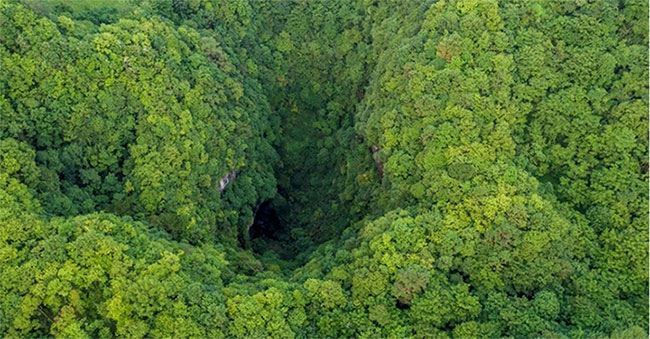Discovered a cave containing a primeval forest
The newly discovered cave in China, with a volume of up to 5 million cubic meters, is considered an oasis of paradise.
Geologically, Karst is a limestone massif that has been eroded by water into large cavities and formed a deep chasm or canyon.

A karst sinkhole in Xuan'en district, not a newly discovered sinkhole.
Recently, a team of Chinese scientists discovered a new giant limestone cliff in Leye county, southern China. What is special is that inside it is a well-preserved primeval forest, with trees up to 40 meters tall.
This huge sinkhole was identified in Guangxi Autonomous Region (in Leye County), Southern China. In this area, about 30 deep pools have been discovered.
According to the US National Karst and Cave Research Institute (NCKRI), southern China has karst terrain that is a breeding ground for spectacular sinkholes.
These karstic landscapes are mainly formed by acidic water reacting with the surface of fissures in limestone or sedimentary rocks, corroding resulting in cracks that widen over time and form fissures. deep abyss, huge cave.
These sinkholes are found mainly in China, Mexico and Papua New Guinea, the large sinkholes known in Chinese as Tiankeng (heavenly pit).
"Due to local differences in geology, climate and other factors, the karst topography appearing on the surface can be significantly different. So in China, there are many spectacular limestone mountains with huge sinkholes and caves," said the NCKRI director.
In other parts of the world, sinkholes are very small, hard to detect, only one or two meters in diameter.

Currently, 30 new sinkholes have been identified in southern China. Located in wet forests, they are difficult to access and are home to a preserved ecosystem
The newly discovered sinkhole is considered an oasis of life, measuring 306 meters long, 150 meters wide and 192 meters deep, with a volume of more than 5 million cubic meters.
According to Zhang Shuanhou, a senior engineer at the Shaanxi Geological Investigation Institute, the sinkhole is considered large if its diameter is between 300 and 500 meters, and super large if its diameter is over 500 meters.
Inside this new large sinkhole, explorers discovered three cave entrances filled with dense shade trees up to shoulder height, and ancient trees nearly 40 meters tall.
These caves and abysses can create an ecosystem or a conduit to underground aquifers. They will form the main or sole source of water for 700 million people around the world.
The researchers even reported that they wouldn't be surprised to find several species of mammals and insects in these caves.
- Detecting ancient primeval forest under the sea
- Discovering a mysterious cave cave population
- Shocking revelation: Every 6 seconds, a large primeval rain forest across the football field is destroyed
- Discovered a lot of particularly hardy toad fish in Phu Tho
- Discover 7 new caves in Phong Nha - Ke Bang
- Discover beautiful stalactite caves, with strange shapes in Quang Tri
- 57 newly discovered caves in Quang Binh
- The cave is larger than Son Doong
- Sa mu forest giant heritage on the Vietnam - Laos border
- Ma's hidden mystery and ancient coffins
- Ginseng forest is planted
- Discover the 7 most spectacular sea caves in the world
 Is the magnetic North Pole shift dangerous to humanity?
Is the magnetic North Pole shift dangerous to humanity? Washington legalizes the recycling of human bodies into fertilizer
Washington legalizes the recycling of human bodies into fertilizer Lightning stone - the mysterious guest
Lightning stone - the mysterious guest Stunned by the mysterious sunset, strange appearance
Stunned by the mysterious sunset, strange appearance